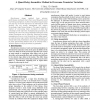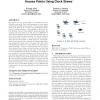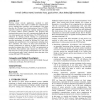403 search results - page 34 / 81 » Gradient clock synchronization |
ASYNC
2003
IEEE
14 years 2 months ago
2003
IEEE
Parameterized first-order models for throughput, energy, and bandwidth are presented in this paper. Models are developed for many common pipeline methodologies, including clocked...
CONCUR
2012
Springer
11 years 11 months ago
2012
Springer
Networks of timed automata (NTA) are widely used to model distributed real-time systems. Quite often in the literature, the automata are allowed to share clocks. This is a problem ...
VLSID
2005
IEEE
14 years 9 months ago
2005
IEEE
Synchronous design methods have intrinsic performance overheads due to their use of the global clock and timing assumptions. In future manufacturing processes not only may it beco...
TMC
2010
13 years 7 months ago
2010
We explore the use of clock skew of a wireless local area network access point (AP) as its fingerprint to detect unauthorized APs quickly and accurately. The main goal behind usi...
SENSYS
2004
ACM
14 years 2 months ago
2004
ACM
Wireless sensor network applications, similarly to other distributed systems, often require a scalable time synchronization service enabling data consistency and coordination. Thi...



